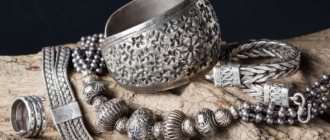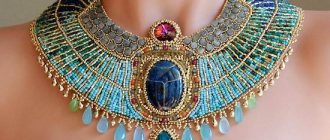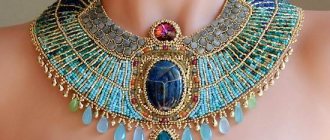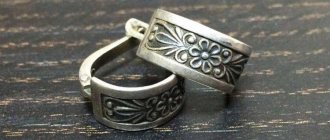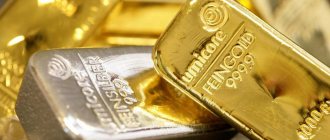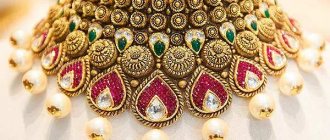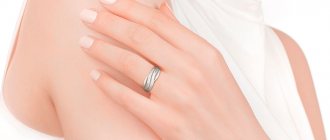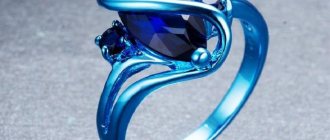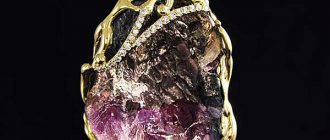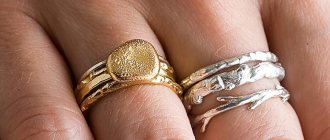Gold jewelry is expensive, so not everyone can afford it. The solution to the problem is gilded silver. These decorations have a pleasant appearance and a relatively modest price. But, gradually they lose their original shine and attractiveness. In order for the gilding to retain its appearance for a long time, such items must be properly cared for and promptly cleaned from darkening.
No. 1. Is it possible to gild silver and how to do it?
It is foolish to look for an answer to the question of whether silver can be plated with gold, since it is obvious. For example, in a jewelry store’s catalog of 32,000 items, there are a thousand with gold plated items. However, gilding has always been a popular way to reduce the cost of jewelry without compromising its appearance. Clay, marble and metal surfaces were gilded both in Ancient Greece (this is mentioned by Homer) and in pagan Rus'. There are two known methods of gilding metals:
Mechanical gilding (leaf). Objects are covered with thin gold plates. To keep the plates in place, they are “set” on an adhesive base or driven into the surface. Gold is a soft and durable metal that can be rolled out down to a micrometer.
Galvanic and electrochemical gilding. After the discovery of electroplating in the 20th century, electrochemical gilding replaced mechanical gilding. It involves placing a metal piece of jewelry in a solution of gold salts and passing a current through it. Metal particles settle on the jewelry, forming a durable layer. Electrochemical metallization allows you to coat jewelry with a finely porous gold layer: it requires a gold-containing gel and a power source. Such a layer wears out four times slower than a galvanic layer.
Gilding silver takes from minutes to an hour if the jeweler uses the second group of methods. The resulting gilding is durable and uniform.
What is gold plating and why is it applied?
Gilding is a coating of high-grade gold that is applied to the surface of a selected item at home or by a professional jeweler in a workshop. The item being processed can be made of any metal, but in most cases silver is used for this.
Gilding is done:
- to give a golden hue and emphasize the individuality of the product;
- updating the appearance of items;
- durability of a metal item.
How the process works
Before gilding silver items at home, it is important to ensure your own safety, for which this is perfect:
- rubber shoes;
- gloves;
- glasses for eye protection;
- apron.
Regardless of the method used, restoring silver at home always consists of the following steps:
- metal surface preparation;
- spraying or other coating;
- final processing.
Gilding metal is not enough. I recommend creating a protective layer on gold-plated silver. Nitrocellulose varnish is suitable for this.
No. 2. How silver jewelry is coated (assays)
If they try to sell you silver with gilding without hallmark at all, don’t even think about agreeing. They are trying to fool you. You can distinguish gold jewelry from silver with gilding by cost and, of course, purity . In Russia, jewelry is not marked with a separate hallmark of gilding, but if you come across a piece of jewelry with a golden sheen and hallmark of silver (a rectangle with top and bottom rounded edges), then you have gilding. On jewelry originating from Europe or the USA, gilding is also marked.
Gold plating structure. Simple gilding consists only of a layer of gold, while reliable and durable plating consists of layers of copper, nickel and 999-carat gold. To protect the gilding from being wiped off, it is covered with a layer of varnish or glass.
Gold plating samples. In jewelry, silver is plated with gold. Silver of the 925th standard, 916th or 875th (USSR standard) behaves best. Such marks will appear on the product in the stamp rectangle. 916 is most likely cutlery silver. Jewelry is plated with 999, 750 or 585 gold. Since gilding is marked abroad, on the product you will find hallmarks of 24, 18 or 14 carat gold. The method of gilding is also indicated in the form of an abbreviation.
Gold plating of 999 purity with a thickness of 3 microns lasts longer. The thickness of the gilding layer, the method of its application and the purity of gold are indicated on the jewelry tag.
Preparation and use of gold chloride
To gold-plate metal, a solution called gold chloride is often used. To prepare such a solution, gold is dissolved in “aqua regia,” which is a mixture of hydrochloric and nitric acids. Hydrochloric and nitric acids are taken in a ratio of 3: 1. Gold is placed in this composition, and then the liquid is evaporated. The procedure for evaporating liquid from such a solution should be carried out very carefully so as not to cause burns to the skin and respiratory tract. The dry substance remaining after evaporation is precisely gold chloride.
When evaporating, you need to separate the open fire from the container with the solution, for example, by making a layer of asbestos chips poured into a separate container
Before using gold chloride for gilding, it must be mixed with a solution of potassium cyanide and washed chalk, resulting in a paste-like mass. Using a brush, this paste is used to cover the product, after which it is left for some time, and then thoroughly washed and polished.
To gild steel, gold chloride is mixed with ether. The product coated with this composition is left for some time until the ether has completely evaporated, and then the treated surface is simply rubbed with a cloth to impart a golden shine.
Using gold chloride, previously mixed with ether, various inscriptions and patterns can be applied to a metal object. In order to carry out this procedure, a quill pen is dipped into the resulting solution and the required inscriptions and patterns are made, which, after evaporation of the ether and polishing, will sparkle with a golden sheen.
Large surfaces are covered with gold using a soft brush
As mentioned above, gold plating is often applied to silver, for which gold chloride can also be used. To perform chemical gilding of products made from this metal, it is necessary to prepare a mixture that includes the following components:
- gold chloride – 10 grams;
- potassium cyanide – 30 grams;
- table salt – 20 grams;
- soda – 20 grams;
- water – 1.5 l.
Chemical gilding, which must be applied to silver, can also be performed using a mixture of:
- gold chloride – 7 grams;
- potassium ferric sulfide – 30 grams;
- potassium carbonate – 30 grams;
- table salt – 30 grams;
- water – 1 l.
The procedure for sputtering a layer of gold onto a metal surface using chemical solutions is performed in the following sequence.
- The product being processed is pre-calcined.
- The surface of the object is etched first with a solution of sulfuric acid and then with nitric acid.
- The pickled product is momentarily dipped into a mixture consisting of sulfuric, nitric and hydrochloric acids.
- After treatment in a mixture of acids, the product is rinsed with water, then immersed in mercury and finally in water, where it is kept for 30 seconds.
- After a container of water, the product is placed in a solution for gilding, kept for the required time, then washed with water and dried in sawdust.
No. 3. How long does gold plating last on silver?
As you already know, the average lifespan of gold plating is two years of constant wear. This means that wedding rings, crosses and chains will have to be updated. In this case, silver will gradually appear through the gold layer - first at the joints, edges of jewelry or places of constant contact with the edge of clothing. It is the uneven color fade that irritates jewelry owners.
The most durable gilding is a layer of 3 microns of 999-carat gold applied to 925-carat silver. Gold adheres securely to silver, is resistant to household chemicals and friction, it is difficult to scratch, does not crumble or peel.
How to wear gold plated? How long gilding on silver lasts depends on how it is handled. To extend the life of the gold plating, remove jewelry when playing sports, before swimming pools and saunas, when cleaning, and when sleeping.
Cleaning gold plated jewelry. It is not difficult to damage the gold layer on silver - for example, with a rough brush or abrasive. Wipe off small stains with an alcohol solution or vinegar on a cotton swab, and large stains with a toothbrush and paste or saline solution.
Minuses
- Constant control in the sock . Jewelry made of gilded silver must be protected from constant contact with the body and water. This means that you cannot wear them while sleeping, playing sports, going to the pool, swimming in the sea, or spending a long time in the sun. Sweat, salt and bleach act as reagents that destroy the applied layer. After the first contact with them, the thing will become unusable.
- Super shine . The high-grade gold used has a distinctive luster that cannot be found in real gold items. Because of this, it shows that the product is fake.
- Corrosion . The green or black marks that silver leaves on the body during oxidation are difficult to avoid, even if it is gold-plated. Unfortunately, this layer is too thin to avoid the problem, and the palm side of the fingers will start to show streaks after a few days of wear.
- Gilded utensils require constant labor-intensive care after each use. It cannot be washed in the dishwasher or used with chemicals or soaps. And each time prepare a special solution that needs to be used to treat objects.
- It's easy to buy a fake . It is easy for the average person to confuse high-grade gilding from low-grade gilding, which determines the price. That is why, after purchasing, before the first contact, you need to contact a jeweler who will clarify the quality of the product.
No. 4. The advantage of silver with gold plated
Gold looks more impressive than silver - it is visible from afar, it shimmers brighter, and looks more expensive. And since there is no visual difference between gold and gilding, the latter is a good attempt to save money. Rings of the same weight made of silver and gold are sold in stores with a price difference of up to 4 times! Although in jewelry everything depends on the skill of the jeweler, the stones and the volume of the series.
Among the advantages of gilding are the chemical resistance of the product, protection from cracks, corrosion and tarnishing, as well as low price and visual appeal. Unlike gold jewelry, gold-plated pendants are worn anywhere and anytime. Business ethics does not prohibit this. Gold-plated rings are a budget alternative to silver “engagement rings,” which are unacceptable at a wedding. Silver is given as a gift at an engagement party.
Gilding also has disadvantages. The main one is fragility. You can treat a gold-plated bracelet with care, but it will not become a family heirloom - your grandchildren will get a silver item. Gold coating is afraid of contact with abrasives - since a layer of several micrometers is easily damaged.
Gold plating also peels off unevenly, so you may not be happy with the appearance of the jewelry long before the gilding comes off completely. But don’t panic - it’s easy to restore its layer in a jewelry workshop. The operation will cost from 500 rubles.
Still have questions? Leave a request and we will contact you!
Order a consultation
We recommend that you familiarize yourself with the catalogs:
- Gold plated rings
- Earrings with gold plated
- Pendants with gold plated
- Gold plated chains
- Gold plated bracelets
What is gold plated silver?
Gilding is the application of a thin layer of 999-carat metal. The thickness of this coating is only 5-10 microns. Sometimes a layer is made between silver and gold, for example, from platinum.
A protective coating is applied over the gold, which makes the product more wear-resistant. 925 sterling silver is often used as the basis for jewelry. Reviews of gold-plated jewelry indicate that at first glance it really resembles gold. It's worth paying attention to because it's much cheaper.
Sometimes, to make gilded items more shiny, they are polished using a special agate stone. Not only jewelry, but also cutlery is made from gilded silver. Such table sets are much lighter than regular ones, so they are convenient to use. Gilded silver does not corrode.
